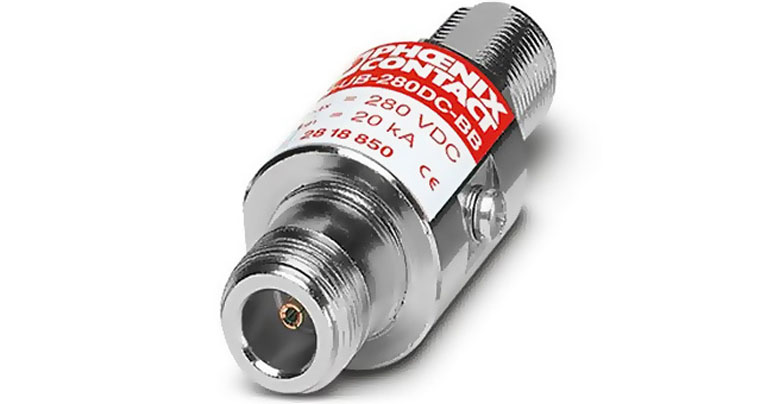Surge Protection is indispensable for electrical networks; says Phoenix Contact
By EPR Magazine Editorial March 7, 2022 6:09 pm IST
By EPR Magazine Editorial March 7, 2022 6:09 pm IST

Electrostatic discharges (ESD) occur if bodies with different electrostatic potentials approach each other, resulting in a charge exchange.
Every electrical device has a specific dielectric strength. If the level of a surge voltage exceeds this strength, malfunctions or damage can occur. Surge voltages in the high or kilovolt range are generally transient over voltages of comparatively short duration. They generally last for a few hundred microseconds. As the maximum amplitude of such transients can amount to several kilovolts, steep voltage increases further damage the system as a consequence.
The failure often occurs in a short period of time and can become a heavy financial burden, especially in comparison to the cost of a lightning and surge protection concept.
Reasons of surge
Lightning bolts
Above all other causes of occurrence, surge strikes (lightning electromagnetic pulse, LEMP) have the greatest potential for damage. They cause transient overvoltages that can extend across great distances and are often associated with high-amplitude surge currents. Even the indirect effects of a lightning strike can lead to a surge voltage of several kilovolts and a surge current of tens of thousands of amperes.
 Switching operations
Switching operations
Switching operations (switching electromagnetic pulse, SEMP) can generate induced surge voltages that spread to supply lines. In the case of large switch-on currents or short circuits, very high currents are followed within microseconds.
 Electrostatic discharge
Electrostatic discharge
Electrostatic discharges (ESD) occur if bodies with different electrostatic potentials approach each other, resulting in a charge exchange. A sudden charge exchange leads to a brief surge voltage. This presents vulnerability, especially for sensitive electronic components.
 Surge and damage
Surge and damage
Production delays, high maintenance costs, high production costs, idle work force, and delayed deliveries are some of the effects of the surge on our work efficiency. Uncontrolled surges will always cause damage to our systems, which can be categorised as follows: Destructive – a sudden surge can damage and destroy systems and equipment. External surges are the main reason.
Dissipative – long-term damage to systems occurs as a result of poor power quality, with internal surges being the primary cause.
Disruptive – disruptions to industrial processes, such as downtime or data loss. it is difficult to understand the cause of disruptive damage.
Destructive damage incurs costs in two ways: the cost of replacing or repairing the device and unplanned system downtime. The replacement or repair cost can be much higher than the installation cost of a surge protection device. Downtime caused by a surge can result in a huge financial loss. The mean-time to repair (MTTR) includes time to diagnose, obtain replacement parts, install the parts, and restart the equipment. Replacement of equipment can take several days if parts are not located near the failure sites.For remote locations, it takes days to travel and resolve the failure.
Dissipative damage is the shortened life of equipment. Many small, low-level surges stress equipment components, resulting in failures and unplanned downtime. Sometimes it is highly noticeable in larger facilities. One of the indications is that certain equipment has a longer life in one area of the facility than in another.
Disruptive damage interrupts a process. A surge might cause a signal loss or an alarm, stopping a process until the fault is cleared.
Devices to address surges: power, instrumentation, control, and data.
To properly protect a device, the input power needs to have protection. Additionally, if there are any communication, signal, or data lines entering the device, protection should be installed.
Enhancing performance and the Protection Circle principle
Surge protection design objectives appear to be very obvious and straightforward – clamp voltage as close as possible to nominal voltage and handle more current than expected at the installation location. Determining these seemingly simple design objectives has proven challenging for design engineers, users, and standards committees at the IEC, Bureau of Indian Standards, and National Electrical Code. Because SPD is subjected to extreme electrical events, the end-of-life failure mode is an important design consideration. SPD as a product must fail in a safe manner.
A clear depiction of the lightning protection zone concept is shown by the protective circle in the figure. An imaginary circle should be drawn around the object to be protected. Surge protective devices should be installed at all points where cables intersect this circle. The area within the protective circle is therefore protected in such a way that conducted surge voltage couplings are prevented.
The protective circle must include all electrical and electronic transmission lines in the following areas:
For further details Please contact Phoenix Contact India Pvt. Ltd. F-26/2, Okhla Industrial Area Phase -2, New Delhi – 110020 E-mail- adverts@phoenixcontact.co.in
We use cookies to personalize your experience. By continuing to visit this website you agree to our Terms & Conditions, Privacy Policy and Cookie Policy.